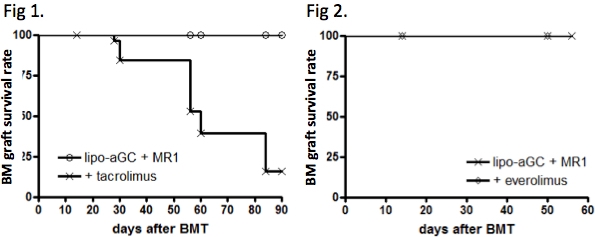Contrasting Effects of Tacrolimus and Everolimus on Regulatory T Cell Activation and Mixed Hematopoietic Chimerism Induced by Natural Killer T Cell Stimulation.
1Urology, Tokyo Women's Medical University, Tokyo, Japan
2Cardiovascular Surgery, Tokyo Women's Medical University, Tokyo, Japan
3Laboratory of Vaccine Design, RIKEN IMS-RCAI, Yokohama, Japan.
Meeting: 2016 American Transplant Congress
Abstract number: D41
Keywords: Bone marrow transplantation, FK506, Immunosuppression, Mixed chimerism
Session Information
Session Name: Poster Session D: Chimerism/Stem Cells, Cellular/Islet Transplantation, Innate Immunity, Chronic Rejection
Session Type: Poster Session
Date: Tuesday, June 14, 2016
Session Time: 6:00pm-7:00pm
 Presentation Time: 6:00pm-7:00pm
Presentation Time: 6:00pm-7:00pm
Location: Halls C&D
Calcineurin (CN)-dependent IL-2 production is crucial for regulatory T cells (Tregs) to demonstrate suppressive activity. The mTOR signal is not required for Treg function because IL-2-signaling stimulated Tregs preferentially induce the JAK/STAT signaling pathway rather than PI3K/AKT signaling. Therefore, CN inhibitors and mTOR inhibitors should have different effects on Treg performance. We previously reported Treg-dependent mixed hematopoietic chimerism (MC) induction therapy comprising of iNKT cell activation by a liposomal formulation of α-galactosylceramide (lipo-aGC) and CD40/CD40 ligand blockade (MR1). Here, we characterized the impact of tacrolimus (TAC) and everolimus (EVL) on Tregs and donor cell engraftment.
3Gy-irradiated BALB/c (H2d) mice were administered bone marrow cellsv(2[times]107) from C57BL/6 (H2b) mice, followed by a single dose of lipo-aGC plus MR1. The mice showed early expansion of splenic Tregs with high Ki67 expression on day7 after bone marrow transplant (BMT) and establishment of robust permanent MC. When TAC was injected consecutively from day1 until day14 after BMT, Ki67 expression on splenic Tregs were significantly decreased, whereas that on the conventional T cell counterpart did not. On co-cultured with naive H2d+T cells, H2d+CD4+CD25+cells isolated from the splenocytes of control MC mice suppressed proliferation of naive H2d+T cells against H2b+cells, whereas those from TAC mice attenuated this suppressive potential against the donor antigen. Although TAC mice showed transient MC, the engrafted donor cells dwindled, which resulted in a MC brake (Fig1). This abrogation of MC induction was reinforced by TAC in a dose-dependent manner. In contrast, when EVL was injected between day1 and day14, abrogation of Treg expansion and MC induction was not observed (Fig2). These data collectively suggest that TAC, but not EVL, precluded Treg activation by stimulated iNKT cells.
CITATION INFORMATION: Miyairi S, Hirai T, IShii R, Okumi M, Ishii Y, Nunoda S, Yamazaki K, Tanabe K. Contrasting Effects of Tacrolimus and Everolimus on Regulatory T Cell Activation and Mixed Hematopoietic Chimerism Induced by Natural Killer T Cell Stimulation. Am J Transplant. 2016;16 (suppl 3).
To cite this abstract in AMA style:
Miyairi S, Hirai T, IShii R, Okumi M, Ishii Y, Nunoda S, Yamazaki K, Tanabe K. Contrasting Effects of Tacrolimus and Everolimus on Regulatory T Cell Activation and Mixed Hematopoietic Chimerism Induced by Natural Killer T Cell Stimulation. [abstract]. Am J Transplant. 2016; 16 (suppl 3). https://atcmeetingabstracts.com/abstract/contrasting-effects-of-tacrolimus-and-everolimus-on-regulatory-t-cell-activation-and-mixed-hematopoietic-chimerism-induced-by-natural-killer-t-cell-stimulation/. Accessed December 29, 2025.« Back to 2016 American Transplant Congress
